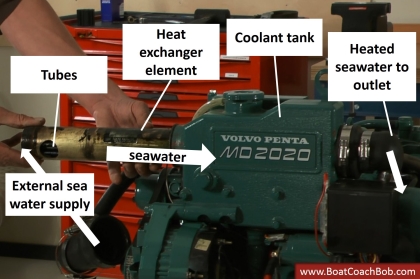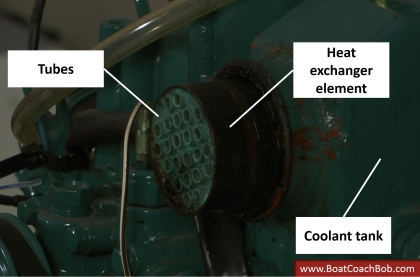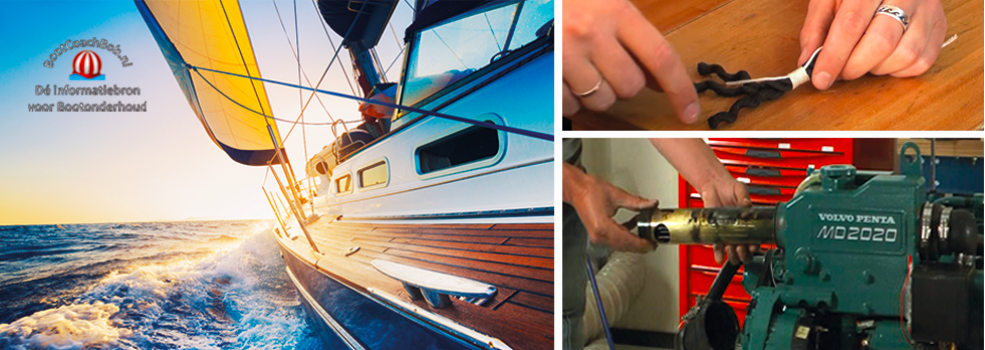In order to keep your diesel engine from jamming or overheating you have to cool it. A boat engine is usually not cooled by air (like a car) but by using external, fresh water for cooling. This can be done in 2 ways:
Difference between direct and indirect cooling
- Direct cooling in which fresh water is pumped through cooling channels inside the engine.
- Indirect cooling through a heat exchanger: The fresh water is not pumped directly through the engine, but through a heat exchanger. This heat exchanger is a casing with tubes inside of it. The fresh water flows through the inside tubes. The hot coolant from the engine circulates outside of these tubes. This is the manner in which the heat exchanger exchanges heat with the coolant that flows through the engine. A disassembled heat exchanger looks like this:

And when the heat exchange element is slid back into the coolant tank it looks like this (left side view of the previous picture):

Pros and cons of direct and indirect cooling
Direct cooling systems are less complicated than indirect cooling systems, since you just have fresh water running through your engine. In an indirect cooling system, two types of fluid must exchange heat which makes the system more complex, of course.
One drawback of direct cooling is that seawater is running through cooling channels inside your engine. This has 2 adverse consequences:
- The salt in seawater more rapidly causes corrosion (rust) than cooling fluid. Coolant often contains corrosion inhibitors to protect the inside of your engine. Not all coolants contain corrosion inhibitors, but almost all coolants from the most common manufacturers (Volvo Penta, Yanmar, Vetus, …) contain these substances. It is recommended that you change the coolant in your engine every 2 years, because the coolant will still cool the engine, but the corrosion inhibitor substance within the coolant will disappear.
- The engine heat causes a buildup of calcium and lime inside the cooling channels. This tends to clog the cooling channels and results in overheating. In a direct cooled engine external water will only be in the heat exchanger and the buildup will thus only occur in the heat exchanger element. Of course this element is much easier to clean than the cooling channels inside your engine.
In a direct cooled engine the risk of salt and lime buildup is more prevalent, therefore the operating temperature of direct cooled engines (55°-70° C or 131°-158° F) is kept lower than that of indirect cooled engines (70°-85° C or 158°-185° F). This operating temperature is controlled by the use of different thermostats that open up at different temperatures. At a lower operating temperature less buildup will occur in your direct cooled engine, which is a good thing. However an engine feels more comfortable at a higher operating temperature (70°-85° C or 158°-185° F). If your engine is continuously running at a lower operating temperature, that will reduce the lifespan of the engine.
An added benefit of indirect cooled engines is the winter resistance: coolant is usually resistant to frost (frost resistance can be measured with an antifreeze scale for example). If something has goes wrong while you were doing the winter layup of your engine, and as a consequence fresh water has frozen inside your cooling system, it could be that only the heat exchanger element is damaged and not the cooling channels in your engine. Of course the heat exchanger element can be expensive, but certainly not as expensive as a whole new engine…
Conclusion
An indirect cooled engine has in most cases more pros than cons. Most new boat diesel engines are indirect cooled engines. If you still have a direct cooled diesel engine, it can be converted into an indirect cooled engine. But doing this (or having this done) obviously depends on your boat budget and/or interest in doing some major tinkering.
Enjoy cooling off!
Bob
